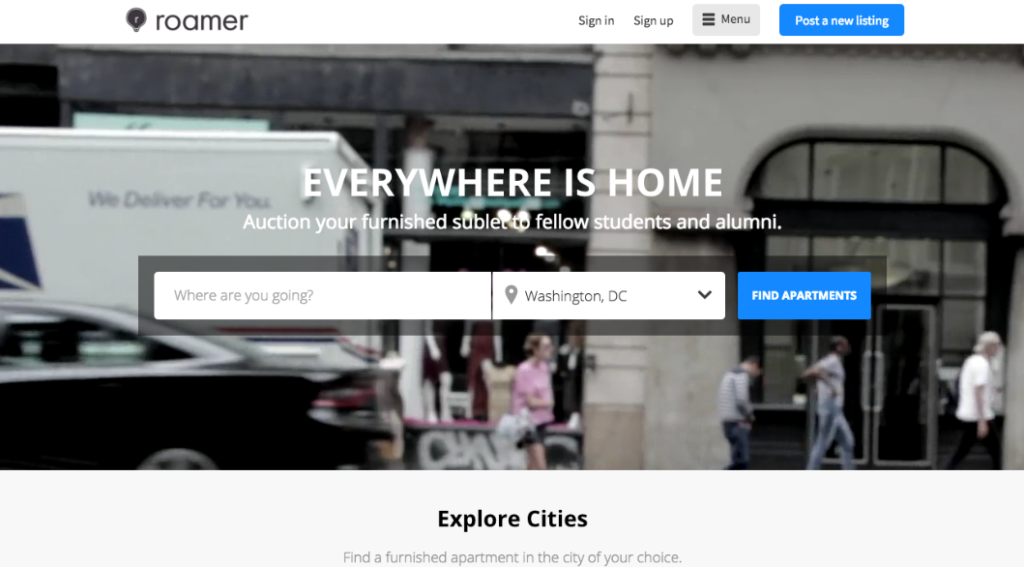It’s fair to say that the subleasing process is broken, or in reality, it has never worked.
With Millennials –particularly students– increasingly on the move for work and adventure, our tech company has developed an elegant solution to solve the month-to-month subleasing problem.
Part social network and part auction house, Roamer is a subleasing marketplace where students and alumni freely negotiate and auction their furnished apartments. The fact that Roamer is closed off to students and alumni creates trust among our users. We built Roamer to try to solve it and to empower our generation to live wherever we want to at any time. Through Roamer, anyone can auction or find a furnished sublet for the summer, semester, or a few random months.
The fact that Roamer is closed off to students and alumni creates trust among our users. And with Roamer, rent is determined by actual demand, and not based on arbitrary prices. Roamer users decide what is fair to pay through our bidding mechanism and hosts make some extra cash based on the potentially above-market value of their apartment. We caught up with RIZZARR’s community to share more about Roamer. Here’s more about Roamer and the impact that it’s creating below!
1. How would you describe Roamer?
Roamer is a real-time auction except there is no time limit on the auction and hosts are not required to pick the highest bidder. This model allows hosts to find the perfect guest and guests to find the right apartment. A host is evaluating a variety of information beyond price in selecting the right person. Roamer equalizes market and user information, allowing bidders and hosts to find the best match in terms of price, availability, and other factors that can go into the process.

2. How does Roamer work?
Well, first, Roamer is completely free. All you need to sign up is either a .edu or corporate email address; this maintains trust in our community. Once you’ve signed up, you can either search for a furnished sublet in any city across the United States or post your own listing. To post a listing, you enter your address, describe your apartment, convey your availability over the year, and upload pictures. Finally, you set a reserve price for your listing. It’s completely up to you what your reserve price will be, but users usually to start with the amount that they pay in rent. Once your listing is live, Roamer users can bid on your apartment. Roamer bids consist of three things: (1) the rental price, (2) the length of stay, and (3) a personal message to the host where guests describe themselves, why they are coming to your city, whether they have any pets, and other relevant info. As a host, you receive all three components of a Roamer bid in your inbox. As more users submit bids and the price goes up, early bidders can update their bid.
3. How does Roamer help hosts?
Hosts receive each bid in their inbox and can also keep an eye on the real-time bid feed below their listing. At any time, they can start a conversation with a bidder they are interested in and if things go well, take the transaction offline. If a host lists an apartment in a popular market — like DC, New York, or Los Angeles — a host could end up making hundreds of dollars in profit, because the apartment is actually more valuable as a furnished summer apartment than is reflected in its monthly rental price. On the other hand, if an apartment is located in a less traveled market, that will also be reflected in its price. In the past, people have often left their apartment empty over the summer if they live in a less popular city. Through Roamer’s dynamic pricing, however, Roamer allows these hosts to recoup at least half or three-fourths of their rent. Without Roamer, these hosts would not likely get anything while they are away.
4. Why did you start Roamer?
We started Roamer because we identified a real problem in our own lives and the lives of our peers: students, alumni, and young professionals. Nobody has succeeded in solving the subleasing problem. It’s a hassle to safely and easily find a furnished apartment for several months at a reasonable price; it’s also a nightmare to find someone trustworthy to take over your place while you’re away. Roamer provides a solution that maximizes transparency, ease of use, and trustworthiness, while limiting the hassles of subletting.
5. What are you hoping students can gain from Roamer? What are you hoping to make a dent in?
Roamer was built from our frustration with subletting and so we hope to save people time and anguish. We want to maximize the matches between the tenants and like-minded hosts. Having lived in multiple cities, we know how important your home away from home can be. We hope to facilitate those connections and match those people together and make the world a slightly better place.
6. What has your success been to date? What’s the impact been?
For our first iteration of Roamer, which launched in March 2015, we attracted 2,000+ users and completed 500+ transactions. Many apartments in major cities received between 50 and 100 bids or offers. We’ve now rebuilt the site from scratch, and currently have approximately 3,000 users made up of students and alumni from across the United States.
7. What are your plans for the near future?
We are always looking to make the Roamer experience as seamless for our users as possible. In the near future, we will grow and create a larger website with more users. This will allow our existing users more choices to find sublets over the summer. In the further future, we will add features to make it easy for people to do all aspects of subletting on Roamer from finding low-priced insurance to making payment online.
8. How can students start using Roamer?
Anyone can sign up by visiting our website, www.roamer.io! You can also follow us on Twitter at roamer_io or like us on Facebook.










